Looking for insight and tips about fiddle leaf fig tree care? Learn the essentials like the proper light, water, and problem-solving tips in thetreecareguide.com, and keep your Ficus lyrata (fiddle leaf fig tree) healthy and vibrant with these simple steps.
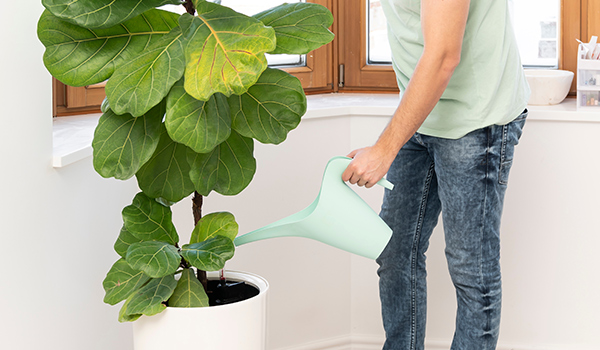
Key Takeaways
- The Ficus lyrata, also referred to as Fiddle-leaf Fig Trees thrive in bright, indirect light and need well-draining potting soil to flourish.
- Consistent watering, with the top inch of soil drying out between waterings, is crucial to prevent root rot.
- Regular pruning and repotting support healthy growth while keeping an eye out for pests, which helps maintain plant health.
Light Requirements for Fiddle Leaf Fig Trees
Light significantly influences the healthy growth of fiddle-leaf fig trees. These plants thrive in bright, indirect light and require about six hours of light daily to maintain their lush foliage. Positioning your fiddle leaf fig near a window with plenty of natural light, such as an east-facing window, can provide the ideal light conditions.
However, direct sunlight should be avoided as it can burn the plant’s leaves and cause irreversible damage. If you notice brown or crispy leaves, it could indicate that your plant is exposed to too much direct sunlight. Instead, opt for filtered light or sheer curtains to diffuse the sunlight.
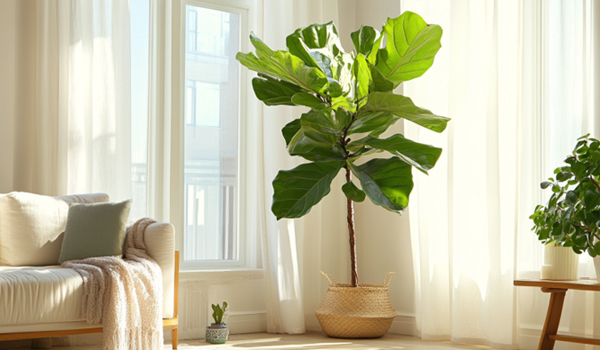
Rotate the plant slightly every few weeks to ensure balanced light exposure. This simple practice will help your plant grow evenly and prevent one side from becoming leggy or sparse. Adequate light exposure is pivotal in maintaining the fiddle leaf fig’s vibrant, glossy leaves.
Fiddle leaf figs can adapt to brighter light conditions but will struggle in low light. If your home doesn’t receive enough natural light, consider using a grow light to supplement. This way, your fiddle leaf fig can flourish and enhance your living space with its striking foliage, creating a bright light environment.
Choosing the Right Potting Soil
Choosing the right potting soil is fundamental for a healthy fiddle leaf fig. These plants need well-draining potting soil that retains moisture without becoming waterlogged. A peat-based soil mixed with perlite or a 50/50 blend of cactus and houseplant soil is ideal for promoting optimal growth. These mixes ensure excellent water retention, breathability, and texture, crucial for the plant’s root health.
Soil pH is another important factor to consider. Fiddle leaf figs thrive best in a soil pH range of 6-7, supporting optimal nutrient absorption and overall plant health. Specialized fiddle leaf fig potting soil offers the necessary nutrients and drainage for optimal plant health.
When choosing a pot, consider the following:
- Opt for one that complements your home decor but also meets the plant’s needs.
- Clay or earthenware pots are excellent choices as they promote better airflow and prevent water from stagnating.
- Ensure that the pot has sufficient drainage holes to prevent problems like root rot, which can occur due to excess water.
Watering Your Fiddle Leaf Fig Tree
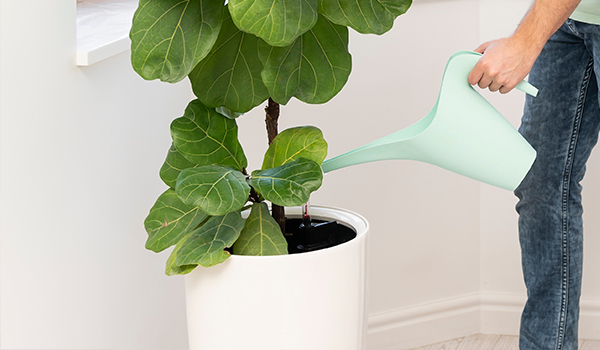
Correct watering is crucial for the health and growth of your fiddle leaf fig tree. These plants prefer their soil to be consistently moist but not waterlogged. Water your fiddle leaf fig when the top inch of soil is dry, typically about once a week or every two weeks. Signs that your plant needs water include droopy foliage and wilting leaves.
Overwatering can be detrimental, leading to root rot and other serious issues. Ensure that the plant drains completely after watering, allowing excess water to escape from the pot’s drainage holes. Flushing the soil monthly until water drains out of the pot can help prevent salt buildup, which can harm the plant.
For self-watering planters, let the reservoir empty completely before refilling. This practice helps prevent excess water from sitting around the roots and causing potential damage. Use filtered or tap water to hydrate your fiddle leaf fig, ensuring it’s free from harmful chemicals.
After watering, allow your fiddle leaf fig to sit in the sink for at least an hour to ensure thorough drainage. Consistent watering helps your fiddle leaf fig thrive, keeping its leaves lush and vibrant.
Temperature and Humidity Needs
Fiddle-leaf fig trees thrive in a temperature range of 60°F to 85°F, making them well-suited for most indoor environments. Avoid placing your fiddle leaf fig near air conditioning units, doors, or vents, as cold drafts can stress the plant. Consistent temperatures will help your fiddle leaf fig maintain its health and growth.
Humidity is also crucial for fiddle leaf figs. These plants prefer humidity levels between 30% to 65%. In the winter months, when indoor air tends to dry out, using a humidifier can help maintain the necessary humidity levels for your fiddle leaf fig. Good air circulation is also essential, as it prevents issues related to humidity and helps the plant thrive.
To keep your fiddle leaf fig comfortable, avoid placing it in drafty areas and ensure it has access to adequate air circulation. These measures help create an environment that mimics the plant’s native tropical habitat, promoting healthy growth and vibrant foliage.
Fertilizing Fiddle Leaf Fig Trees
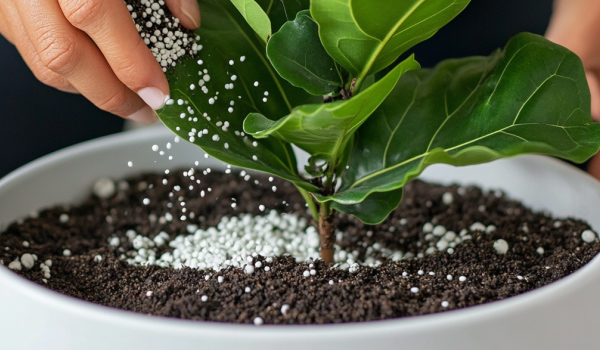
Fertilization supports the growth and overall health of your fiddle leaf fig tree. These plants have large, dense leaves that require significant nutrients, making consistent fertilization necessary. Fertilize fiddle leaf figs monthly during the growing season, typically from spring through summer.
When choosing a fertilizer, look for one with an NPK ratio of 16-5-11, as this provides a balanced supply of nutrients that fiddle leaf figs need to thrive. Liquid fertilizers are particularly effective, allowing for easier control over nutrient delivery compared to slow-release granules. A common recommendation is to mix one teaspoon of liquid fertilizer per cup of water for optimal results.
If you’ve recently repotted your fiddle leaf fig, wait about a month before starting a regular fertilization routine to minimize root shock and allow the plant to acclimate to its new potting soil. Following these fertilization tips ensures your fiddle leaf fig remains healthy and vibrant throughout the growing season.
Pruning and Shaping Fiddle Leaf Figs
Pruning and shaping are important for maintaining the health and appearance of your fiddle leaf fig tree. The best time to prune is in late spring or summer when the plant is in its active growth phase. Using a small pair of pruning shears, make cuts at a 45-degree angle to encourage healthy growth and prevent damage to the plant.
When pruning, top the main trunk above a leaf node to encourage branching and a fuller appearance. This practice stimulates new growth and helps create a more balanced and attractive shape. Some growers prefer a tree-like appearance with a branched canopy, achieved through regular pruning.
Always wear gloves when pruning to protect your skin from the white, milky sap that is excreted when the plant is cut. Removing dead leaves at any time helps maintain the plant’s health and prevent potential pest issues. Regular pruning and shaping keep your fiddle leaf fig looking its best and promote vigorous growth.
Propagation Techniques
Propagating fiddle leaf figs can be a fun and rewarding way to expand your plant collection. There are three primary methods for propagating these plants: stem cuttings in soil, cuttings in water, and air-layering. The ideal time for propagating is during late spring to early summer when conditions are warm and bright.
For soil propagation, prepare a 6-inch stem cutting with 2-4 nodes, cutting at a 45-degree angle. Ensure your tools are sterilized to prevent the introduction of diseases. Keep the cutting in a covered environment to maintain humidity and encourage root growth.
Water propagation involves placing the cutting in water and monitoring it weekly for root development, which typically takes around six weeks.
Air-layering requires making an incision around a branch’s outer tissue and covering it with damp sphagnum moss to promote root growth. Once roots develop, the branch can be cut and potted in soil for further growth. Each method has its benefits, so choose the one that best fits your needs and resources.
Repotting and Pot Maintenance
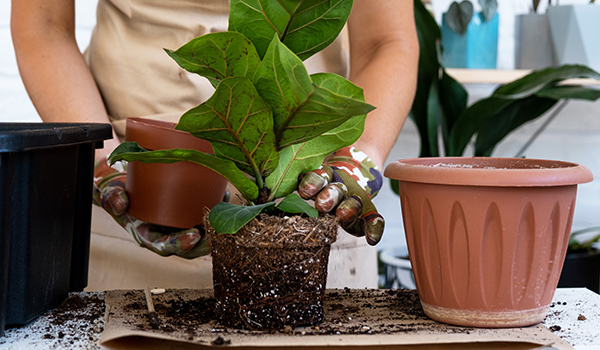
Repotting is an essential part of fiddle leaf fig care, especially for young plants. Young fiddle leaf figs should be repotted annually every spring, while mature plants can have the top several inches of soil removed and replaced with fresh soil. This ensures the plant has access to new nutrients and room for root growth.
When repotting, choose a pot that is 3-4 inches wider in diameter than the current pot. Clay or earthenware pots are ideal as they provide better airflow and prevent water from stagnating. Make sure the pot has adequate drainage holes to avoid root rot and other issues that can arise from excess water.
After repotting, wait about a month before resuming fertilization to minimize root shock. Proper pot maintenance and repotting practices help your fiddle leaf fig thrive and continue to grow healthily.
Common Pests and Diseases
Fiddle-leaf fig trees can be susceptible to various pests and diseases. Common pests include:
- spider mites
- scale insects
- mealy bugs
- aphids
- thrips
- fiddle leaf fig plant
These pests can cause significant damage if not addressed promptly. Adequate air circulation and a good watering plan help prevent pest problems.
Neem oil is a recommended treatment for many pests. It works by being absorbed into the plant’s system, poisoning pests effectively. However, caution should be taken to avoid overuse, as it can weaken plants and cause discoloration. Regular checks and preventive treatments keep your fiddle leaf fig free from pests and diseases.
In addition to pests, fiddle leaf figs can suffer from bacterial infections. Maintaining a clean environment and promptly removing affected leaves can help prevent the spread of disease. Staying vigilant and addressing issues early before they become major will help keep your fiddle leaf fig healthy and thriving.
Troubleshooting Common Issues
Despite the best care, fiddle leaf figs can sometimes encounter issues. Signs of inadequate light include droopy leaves and foliage that appear pale or spotty. Excessive direct sunlight may cause light brown or bleached spots on the leaves. Relocating the plant to a spot with bright, filtered morning light can help alleviate these problems.
Overwatering is another common issue that can lead to dark spots on leaves and root rot. To prevent this, ensure proper drainage and avoid letting the soil shrink away from the pot’s sides. Leaf loss can also occur if the plant is moved around excessively, so try to keep your fiddle leaf fig in a stable location.
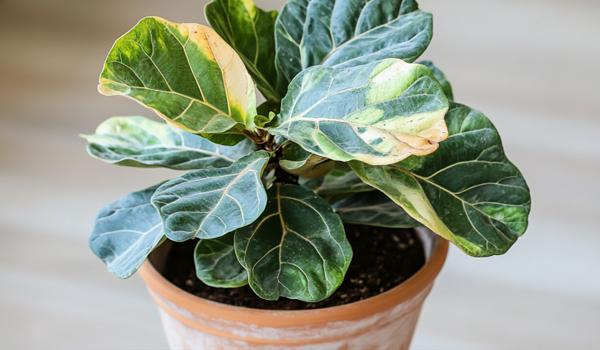
Temperature extremes and direct airflow from heating or cooling units can cause leaf discoloration. Ensuring your plant is in a suitable environment with consistent conditions will help prevent these issues and keep your fiddle leaf fig in optimal health.
Additional Care Tips
Consider these additional care tips to maintain the health and vibrancy of your fiddle leaf fig tree. Routine preventive treatments for pests are recommended to keep your plant free from infestations. Grouping plants together can also enhance humidity levels, creating a more favorable environment for your fiddle leaf fig.
Use a damp cloth to gently wipe a few leaves once a month to remove dust and maintain their shine and health. This practice also helps the plant absorb more light. If you notice brown spots on the leaves, it may indicate a need for increased humidity or adjustments in watering practices.
Following these extra tips ensures your fiddle leaf fig remains a stunning and healthy addition to your home.
Fiddle Leaf Fig Care Summary
Caring for a fiddle leaf fig tree involves understanding its specific needs, from light and soil requirements to proper watering, temperature, and humidity control. By following the guidelines on fertilizing, pruning, propagating, and repotting, you can ensure your fiddle leaf fig remains healthy and vibrant. Regular monitoring for pests and diseases and addressing common issues promptly will help maintain your plant’s well-being. Remember, with a bit of patience and attention, your fiddle leaf fig can thrive and become a beautiful, long-lasting addition to your indoor garden.
Frequently Asked Questions
How often should I water my fiddle leaf fig tree?
You should water your fiddle leaf fig when the top inch of soil feels dry, typically once a week or every two weeks. Just keep an eye on it and adjust based on your home’s humidity and temperature!
What kind of light is best for fiddle leaf figs?
Fiddle leaf figs love bright, indirect light and ideally need about six hours of it each day. Make sure to place yours where it can soak up that light without direct sunburn!
Can I use regular potting soil for my fiddle leaf fig?
Regular potting soil isn’t ideal for your fiddle leaf fig; it’s better to go for a peat-based mix with perlite or a blend of cactus and houseplant soil for optimal drainage and nutrients. Your plant will thrive with the right mix!
How do I prevent pests on my fiddle leaf fig?
To keep pests off your fiddle leaf fig, ensure it has good air circulation and follow a consistent watering routine. Don’t hesitate to use neem oil or fungicides if you notice any issues.
Why are the leaves of my fiddle leaf fig turning brown?
Your fiddle leaf fig’s leaves are likely turning brown due to factors like too much direct sunlight, low humidity, or overwatering. Try adjusting its light, increasing humidity, and fine-tuning your watering routine to help it thrive.